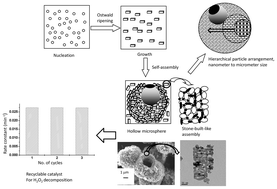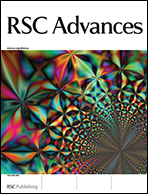A rapid one-pot synthesis of hierarchical hollow mesoporous CuO microspheres and their catalytic efficiency for the decomposition of H2O2†
Abstract
Hierarchical hollow mesoporous CuO microspheres were synthesized by a rapid one-pot hydrothermal method at 150 °C for 2 h, using aqueous based precursors like copper acetate, urea and water. The as-prepared (uncalcined) and calcined (300–500 °C) particles were characterized by differential thermal analysis (DTA), thermogravimetry (TG), Fourier transform infrared spectroscopy (FTIR), X-ray diffraction (XRD), multipoint BET (Brunauer–Emmett–Teller) surface area, field emission scanning electron microscopy (FESEM), and transmission electron microscopy (TEM). The catalytic efficiency of the synthesized microspheres was examined by tracking the decomposition of H2O2. The size of the hollow microspheres was 3–8 μm comprised of small particles (100–300 nm) which were formed by the self-assembly of nanometer sized (5–20 nm) particles with a stone-wall-like structure. The formation mechanism of the hierarchical hollow CuO microspheres is discussed. The BET surface area and total pore volume of the 300 °C-treated sample were found to be 51 m2 g−1 and 0.25 cm3 g−1, respectively, and it exhibited the highest catalytic performance for the decomposition of H2O2 with a rate constant of 27.49 × 10−3 min−1, the highest value ever published. The catalytic activity was studied in terms of the textural properties and calcination temperatures of the microspheres. The hollow CuO microspheres were used as recyclable catalyst.


 Please wait while we load your content...
Please wait while we load your content...